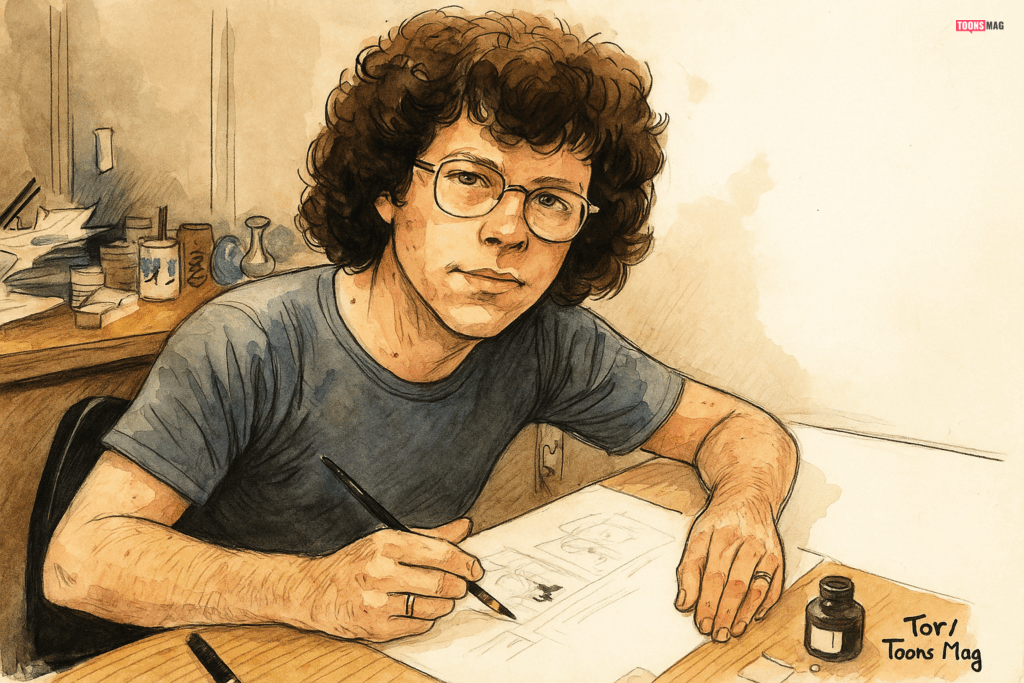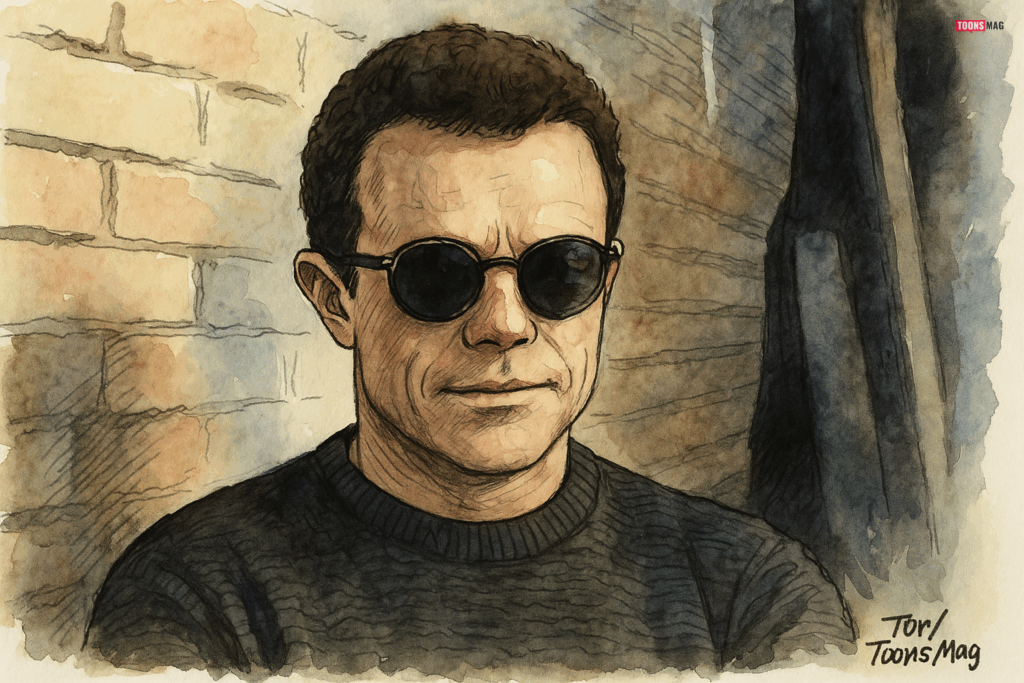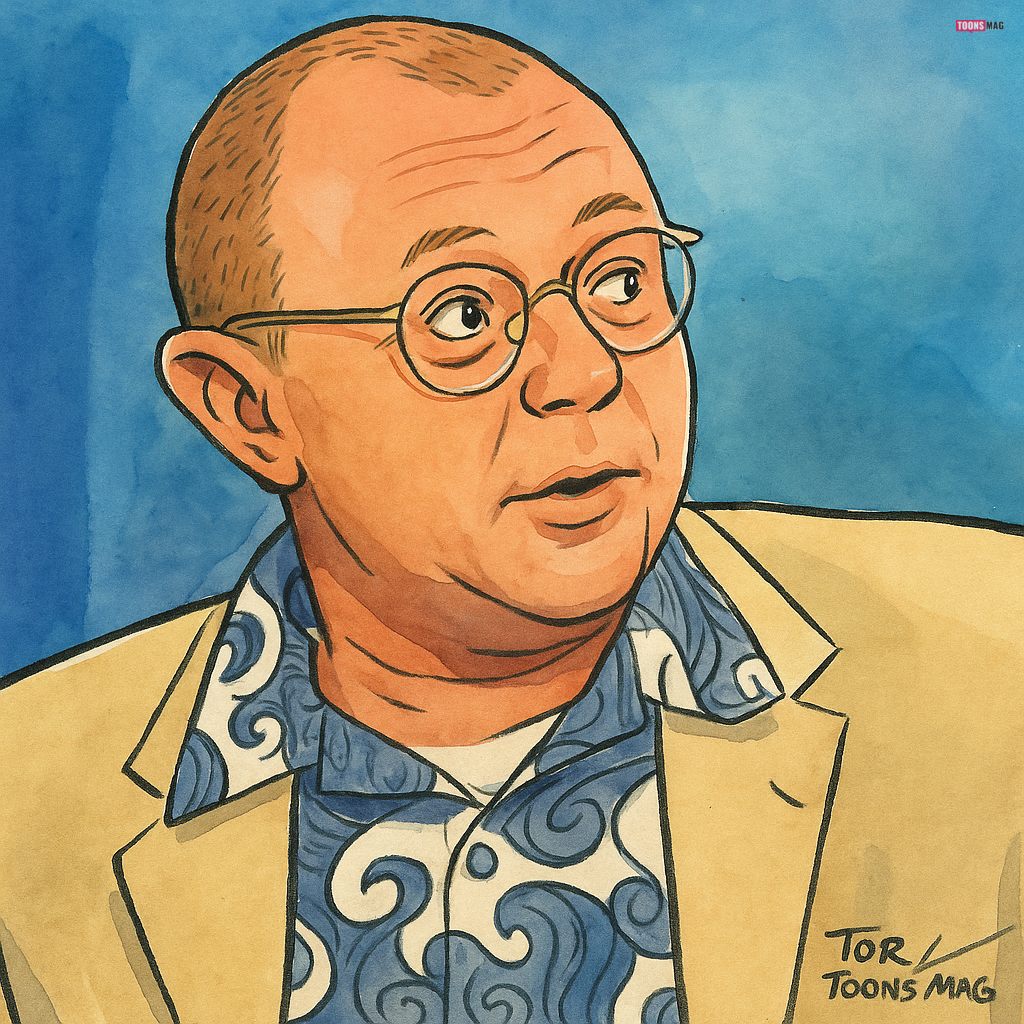Patrick St. John Cook aka. Patrick Cook (born 6 August 1949) is a renowned Australian cartoonist, satirical writer, performer, and cultural commentator whose biting wit and illustrative style helped define the tone of Australian political commentary for more than five decades. Known for his prolific work in The National Times, The Bulletin, The Financial Review, and on iconic television programs such as The Gillies Report and The Dingo Principle, Cook brought satire to new heights—melding caustic humour with historical perspective, theatrical flair, and unflinching critique.
Infobox: Patrick Cook
Full Name: Patrick St. John Cook
Born: 6 August 1949, Weymouth, England
Nationality: Australian
Occupation: Cartoonist, Satirical Writer, Performer
Education: Newington College
Known For: The National Times, The Bulletin, The Gillies Report, The Dingo Principle, The Big Gig
Spouse: Jean Kittson
Children: 2 daughters
Notable Works: “Not the News” column, Harry Seidler Retirement Park cartoon, Keating: Shut Up and Listen, The Ultimate Book of Names
Awards: Multiple Walkley Awards for journalism and cartooning
Years Active: 1971–present
Early Life and Education
Patrick Cook was born in Weymouth, England, on 6 August 1949, into a British naval family whose postings and travel may have subtly shaped his early curiosity about empire, power, and cultural identity. He emigrated to Australia as a child, settling in suburban Sydney—a seismic cultural and environmental shift that would later influence his sharp, observational humour and his status as a self-proclaimed outsider in Australian society. He often remarked that this dislocation helped him see Australia not with a native’s complacency but with the critical lens of someone perpetually fascinated by its contradictions.
Educated at Newington College, a prominent private school, Cook was exposed to both the rigidities of conservative Australian institutions and the irony-laden absurdities that would fuel his future work. He showed early signs of being a gifted storyteller and performer, often delighting and scandalising teachers with cheeky line drawings, subversive essays, and offbeat school plays. Despite what would become a celebrated visual career, Cook received no formal art training, an absence that perhaps contributed to the rawness and originality of his style. Instead of academic instruction, his aesthetic was shaped by political cartoons in newspapers, classical paintings, comic books, and British satire like Punch and Private Eye.

His earliest forays into satire emerged while contributing illustrations, satirical columns, and humorous observations to university newspapers and small underground publications. He gravitated toward student politics—not as a candidate, but as a cartoonist who could distill the messiness of campus activism into wry visual commentary. These early works displayed not only his technical dexterity but also his razor-sharp intuition for decoding systems of power, hypocrisy, and bureaucracy. He had a particular interest in historical parallels, often inserting references to ancient Rome, the Enlightenment, or naval history into what would otherwise be contemporary sketches.
Cook’s professional break came in 1971 when his close friend, the prolific writer and political raconteur Bob Ellis, introduced him to the radical newspaper Nation Review. The publication was a magnet for cultural and political dissenters—a perfect match for Cook’s acerbic intellect and artistic irreverence. It was a world where writers, artists, and critics tackled the establishment with typewriters, ink, and wit.
Cook dove in with a dip pen, a rebellious spirit, and what some described as the angelic face of a troublemaker. His arrival at Nation Review was not just timely; it was transformative. He immediately stood out for his ability to blend outrageous imagery with erudite historical references. What he delivered wasn’t just political satire—it was social autopsy disguised as comedy.
He quickly earned a reputation as a provocateur, someone who saw no sacred cows and used every tool in his creative arsenal to mock the powerful and amplify the absurd. From this moment, Cook was no longer simply a cartoonist—he was a cultural force in the making, reshaping the contours of Australian satire for the decades to come.
Rise to Prominence
Cook’s work quickly attracted attention for its brutal candour and grotesque caricatures. In The National Times, he became a dominant force, setting the editorial tone of a publication that prided itself on investigative rigour and intellectual dissent. His scathing critiques of politicians, bureaucrats, and cultural figures didn’t merely complement the news—they helped shape public perception. Cook’s illustrations were so distinctive and biting that they often became conversation pieces in Parliament House, featured in television news wrap-ups, and discussed in editorial meetings of rival newspapers. His drawings did more than amuse—they confronted, provoked, and held public figures to account in ways words sometimes could not.
One of the most defining moments of his early career occurred in 1982, when world-renowned modernist architect Harry Seidler filed a lawsuit against Cook and The National Times. The offending cartoon was a minimalist satire titled “Harry Seidler Retirement Park,” which featured concrete boxes where food was inserted at the front and waste collected at the rear—a visual jab at Seidler’s architectural style and public persona. The cartoon struck a nerve not just with Seidler, but with a portion of the artistic and architectural establishment who debated whether satire could, or should, cross into critical judgment of aesthetics and personal legacy.
The resulting legal battle—Harry Seidler & Associates v. John Fairfax & Sons Ltd—was widely followed by the public, with courtroom sketches, press coverage, and debates on free speech regularly making front pages. The case put Australia’s tolerance for satire to the test and became a touchstone in conversations about the balance between artistic freedom and defamation. When the jury ruled in Cook’s favor, the decision was hailed as a victory for freedom of expression and became a precedent cited by legal experts and editorial teams for years to follow.

The outcome emboldened cartoonists across Australia and marked a turning point in the nation’s cultural acceptance of biting political humour. It sent a clear message: satire had a protected and respected place in democratic discourse. In the aftermath, Cook’s notoriety surged—his work was suddenly part of case law, and he was invited to speak on panels and appear on interviews discussing satire’s societal role. The cartoon, once contentious, became an iconic image in Australian press history, forever associated with the expansion of artistic and journalistic freedom.
Multiplatform Satire: Print, Puppets, and Performance
By the mid-1980s, Cook’s talents had extended well beyond the newspaper page. He became a star of the ABC’s golden era of televised satire, co-writing and starring in shows that defined political humour for a generation. Among them were The Gillies Report (1984–85), The Dingo Principle (1987), Good News Week, The Party Machine, and The Big Gig, which ran for seven seasons and became a cult classic.
These programs became mainstays of Australian television not just because they were funny, but because they tackled subjects few dared to touch, offering a mix of parody, sketch comedy, impersonation, and scripted satire that held a mirror to national and international politics. Cook’s portrayals, both behind the scenes and in front of the camera, were marked by a deadly accuracy that left audiences laughing—and sometimes gasping.
His satirical television work was bold, often provoking outrage—and even international diplomatic incidents. The Dingo Principle, in particular, led to official complaints from governments including Japan, Iran, and the Soviet Union, each objecting to segments that poked fun at their political systems or leaders. One sketch mocking Soviet politics resulted in a formal letter of protest from the USSR’s embassy in Canberra. Another segment parodying Iran’s clerical leadership led to an abrupt change in foreign correspondence protocols between the two countries. These controversies only heightened Cook’s reputation as a fearless satirist who was unafraid to court backlash in the service of humour and truth.
Equally remarkable was his love for theatrical experimentation. In 1980, his puppet show Captain Lazar and His Earthbound Circus made waves at the Adelaide Festival, where it blended surrealism, slapstick, and political allegory in a format that few had seen before. The show featured handmade marionettes, scripted political satire, and Cook’s signature irreverence, creating a cult following and critical acclaim. Cook viewed the puppet stage as another battleground for ideas—a space where he could challenge authority with strings and papier-mâché. It marked him as an innovator not just in cartooning but in visual storytelling and live performance.
He also wrote the celebrated column Not the News for The National Times, crafting absurdist takes on real news stories. The column blended parody, satire, and speculative fiction to offer readers a funhouse mirror version of reality—one in which the absurdities of politics were amplified, not diminished. His columns became must-reads for politically engaged Australians and were often recited on radio and quoted in speeches. His use of deadpan humour, historical allegory, and unpredictable plot twists gave the pieces a literary quality rarely seen in weekly satire.
Later, his transition to The Bulletin cemented his status as a fixture in Australian media. For over 20 years, he illustrated political coverage, including Laurie Oakes’ influential columns, turning them into visual events that readers eagerly awaited. His illustrations were more than just editorial cartoons; they were rich narrative scenes layered with visual metaphors, historical references, and psychological insight. Cook shaped the magazine’s visual language and brought a level of sophistication to political illustration that few could match.
Cook’s Working Life
He had no formal art training, but instead served his apprenticeship as a student in Sydney university newspapers. His mate Bob Ellis had begun contributing to the Nation Review in February 1971 and Cook broke into cartooning there in August 1971,e.g. “A kiss will be quite sufficient, Hardy (who is taking off his pants in front of dying Nelson)” 13 May 1972. He worked for the National Times in the late 1970s,e.g. State Types 1978. Two Cook originals of the 1970s.
Cartoons
A prolific cartoonist, using a mapping pen on Hammer 4G paper in 1988, Cook has contributed to very many major and minor newspapers and magazines, including Cleo, Two Weeks, and Matilda. With David Bromley, Jenny Coopes, Bill Farr, Randy Glusac, and Ward O’Neill, he illustrated Alexander Buzo’s Tautology: I don’t want to sound incredulous, but I can’t believe it (Penguin, Victoria, 1981). In recent years he has mainly drawn for the Bulletin, where he also writes a weekly satirical column. Indeed, satiric writing has increasingly taken over from the drawing, and he is also a writer and actor for TV (and puppet theater).
A member of the Australian Black and White Artists’ Club, Cook lives in Glebe, Sydney, married to the comic actor Jean Kitson. He has a large collection of magazines from the 1950s and ’60s and is a longtime fan of Mad. His cartoons have influenced many others, especially Mark Knight, who drew for the Melbourne Herald in the late 1980s in a very similar style. He regularly exhibits in the NMA’s annual Bringing the House Down, e.g.two cartoons from the Bulletin – ‘Khaki election’ and ‘Yes & no’ – in 2001.
Others achievements
Patrick Cook was first sighted in 1971 in Nation Review, armed with a dip pen and the angelic face of a troublemaker. The blame is widely shared. He was a child of the empire, born British to a naval family – the middle name is St John – educated in a Sydney private school and living in a country that he has never ceased to find exotic. He wore at first the light disguise of an imp. But as time went by – not long – he let loose the rage that drives the great political cartoonists. Everything Cook does – writing, performing, drawings– is driven by rage and pity for all he finds shabby in our world, our politics, and us.
He never doubted the good fortune of being Patrick.“Patrick is a splendid choice,” he wrote in one of his funniest books, The Ultimate Book of Names.” From the Latin ‘noble’, the Greek ‘wonderful’, Ancient Persian ‘fabulous’….” His mind often wanders to the past. History matters a great deal to him. Even at its silliest, Cook’s work takes a long view. He doesn’t savage governments because they’re not as good as the last, or Labor for not being able to match the Coalition.
His scorn ranges over centuries. Caesar, Christ, Simon Bolivar, and Hitler are familiar figures in Cook’s work. Ditto heroes of the Royal Navy. One of his first drawings published had a sailor unbuckling his pants as a dying Nelson declared: “A kiss will be a quite sufficient Hardy.”
Cook set the tone for The National Times as the head prefect of a remarkable band of black and white artists: Jenny Coopes, Michael Fitzjames, Neil Moore, David Bromley, Tony Edward, Matthew Martin, and Ward O’Neill. It was the last great artists’ paper in this country, and however bleak the stories we wrote – and in the Fraser years bleak was the default setting of the paper – Cook had fun. Politicians grew the faces he gave them: a scimitar nose for Whitlam, a child’s lip for Howard, and on Malcolm Fraser a jaw like a pig’s bum.
As newspapers and magazines collapsed beneath him, television became Cook’s other career. For decades now, he has been making actors sound funny. The Gillies Report in the 1980s became a national institution. That triumph was followed by Good News Week, The Dingo Principle – which earned Australia diplomatic rebukes from Russia, Japan and Iran – The Party Machine, and seven seasons of The Big Gig where he met and married the wise and very funny Jean Kittson. They have two grown daughters.
Controversies
Cook did similar damage to the nation’s picture of itself. His Australia is a place of bush flies, barbed wire to the horizon, fat heads under big hats, deluded optimists, sheep – the most human of animals in Cook’s world – barristers in wigs, tea ladies and their trollies, women in overalls and wise koalas.
He was the funniest man around – in The Financial Review in the week and The National Times on the weekend, where he began his celebrated column Not the News. By this time he had discovered the theater (and vice versa) performing and writing dazzling scripts for his friends to perform. A puppet show starring Captain Lazar and his Earthbound Circus(one of his favorite creations)was a cult sensation at the Adelaide Festival of 1980.
Then Harry Seidler was silly enough to sue Cook over an elegant cartoon of a bare landscape dotted with man-high concrete boxes where sandwiches were fed through a slit in the front and shit collected from a slot at the back. The caption read: Harry Seidler Retirement Park. The jury backed Cook. When the great man died every obituary in the world recorded his 1982 humiliation and to this day every Google search of his work turns up the cartoon. As a result of Cook’s victory in Harry Seidler & Associates v. John Fairfax & Sons Ltd, Australian newspapers were funnier and braver for a generation.
When sharp money closed down The National Times, Cook crossed the street to The Bulletinwhere his writing and drawing were celebrated for the next twenty years. Once again, he set the tone. He made The Bulletin look like him. Each week he illustrated Laurie Oakes’ column and on his retirement, Oakes unhesitatingly nominated Cook as the best cartoonist in the country. When sharp money shut The Bulletin in 2008, Cook crossed the street once more and worked for a few years at The Spectator. The empire child was almost home again.
Style and Legacy
Patrick Cook’s cartoons are immediately recognizable. His linework is dense yet agile, grotesque yet expressive, capable of capturing not only a likeness but the psychological essence of his subjects. In a few deft strokes, he could suggest a politician’s entire character or critique their ideological stance. He distilled political personas into visual metaphors: Gough Whitlam’s imperial nose symbolized grandeur and idealism; John Howard’s childlike lips alluded to cautious conservatism and political stubbornness; and Malcolm Fraser’s rear-end jaw invoked aloof detachment and imperiousness. These caricatures became embedded in public consciousness. Even politicians themselves began to internalize Cook’s depictions, with some humorously acknowledging how closely their reputations were tethered to his pen.
His illustrations revealed Australia as he saw it: a rugged, often ridiculous land riddled with contradictions—dotted with barbed wire fences, persistent bushflies, wig-wearing judges, and bureaucrats in dusty suits. He populated this world with marsupials acting as moral commentators and sheep that stood in for voters, conveying deeper truths through the absurd. Koalas became a signature motif—sometimes wise, sometimes ridiculous, always purposeful. Despite being asked by editors to reduce their use, Cook defiantly doubled them. “More koalas!” became a quiet editorial rebellion that turned into a cult-like in-joke among readers and newsroom staff.
Cook’s art was informed by a deep historical awareness and a near encyclopedic memory. His jokes were not always tied to the day’s headlines. Instead, he brought Caesar, Napoleon, Jesus, Bolivar, and Hitler into modern satire, offering a timeless critique of human vanity, hubris, and idiocy. His cultural references created a web of satirical resonance that challenged audiences to connect past and present. He rarely skewered one party or ideology exclusively. His satire transcended party lines and electoral cycles, aiming instead at the structures of power, corruption, and absurdity that span centuries. To Cook, folly was universal and enduring—and his mission was to puncture it with precision, whether on the page, stage, or screen.
Personal Life and Recognition
Patrick Cook is married to acclaimed comedian, author, and performer Jean Kittson, whom he met while working on The Big Gig. Together they represent one of Australia’s great comedic partnerships, a union built on mutual respect, artistic alignment, and shared irreverence. They have two daughters, both of whom have inherited their parents’ creative spark and articulate wit. Their household has often been described by friends and colleagues as a cradle of creative energy—a place where ideas, scripts, sketches, and satire are as commonplace as cups of tea. Cook and Kittson have occasionally collaborated on stage and screen, their styles complementary: her warm absurdism harmonizing with his acerbic barbs.
Cook has been honoured with multiple Walkley Awards for excellence in journalism and cartooning, earning recognition not only for his political insight but also for his originality and fearlessness. He is also the author and illustrator of several books, including Keating: Shut Up and Listen and You Might Learn Something, a biting visual dissection of the Keating era, and The Ultimate Book of Names, a tongue-in-cheek guide that blends etymology with comic invention. His artwork has been exhibited in numerous galleries and featured in retrospectives celebrating Australia’s editorial cartooning legacy. Institutions like the National Library of Australia and the National Gallery of Victoria have acquired his original works for permanent collections, ensuring his contributions are preserved for future generations.

Despite the decline of traditional print journalism, Cook continues to draw, write, and contribute to public conversations through podcasts, special event programs, and occasional guest columns. He has also made appearances at writers’ festivals and academic forums, offering insights into satire’s evolving role in a digitally fragmented media landscape. Any rumours of his retirement are met with disbelief—his brush and his rage remain undimmed, his sense of justice and absurdity still razor-sharp. Cook remains not only a chronicler of Australian life but also a provocateur-in-residence whose commentary, whether visual or verbal, still lands with unmistakable force.
Enduring Impact
Patrick Cook has not only influenced a generation of cartoonists—many of whom cite him as their chief inspiration—but he also reshaped the public’s understanding of what satire could do. His art is not just decoration or mockery—it is political intervention, historical reflection, and cultural critique.
He showed that satire can hold up a mirror to power, expose hypocrisy, and still leave room for laughter. Cook made absurdity into a tool for truth. He invited Australians to see themselves not as heroes or victims, but as flawed and comic figures—fallible, noisy, wonderfully human.
In the shadow of history, Cook sees us all as children—curious, stubborn, and bewildered. It’s a view that inspires compassion as much as critique. And in that blend of rage and pity, of intellect and silliness, Patrick Cook’s work continues to resonate, generation after generation.
FAQ about Patrick Cook aka Patrick St. John Cook
Q1: Who is Patrick St. John Cook?
A1: Patrick St. John Cook is an accomplished Australian cartoonist, satirical writer, and performer renowned for his contributions to publications like The National Times and The Bulletin, as well as his work on television.
Q2: Where was Patrick St. John Cook born?
A2: Patrick St. John Cook was born on 6 August 1949 in Weymouth, England, but later immigrated to Australia during his childhood.
Q3: What were some of Patrick St. John Cook’s early career experiences?
A3: Before becoming a cartoonist, Patrick St. John Cook worked as an illustrator and cartoonist for several Sydney University newspapers. His career took off when he joined Nation Review in 1971, thanks to a recommendation from his friend Bob Ellis.
Q4: Why is Patrick St. John Cook known for his controversial newspaper cartoons?
A4: Patrick St. John Cook gained widespread recognition for his controversial newspaper cartoons, often tackling contentious subjects. His cartoon about architect Harry Seidler led to a court hearing that made front-page news in 1984.
Q5: What accolades have Patrick St. John Cook received for his work?
A5: Patrick St. John Cook has received multiple Walkley Awards, a prestigious recognition in print cartooning.
Q6: Did Patrick St. John Cook have a presence on television?
A6: Patrick St. John Cook co-wrote and appeared in the satirical ABC television series “The Gillies Report,” which aired in 1984 and 1985. He also featured in “The Dingo Principle,” another satirical series broadcast in 1987.
Q7: Is Patrick St. John Cook married?
A7: Yes, Patrick St. John Cook is married to the writer and comedian Jean Kittson, and they have two daughters.
This post was created with our nice and easy submission form. Create your post!




